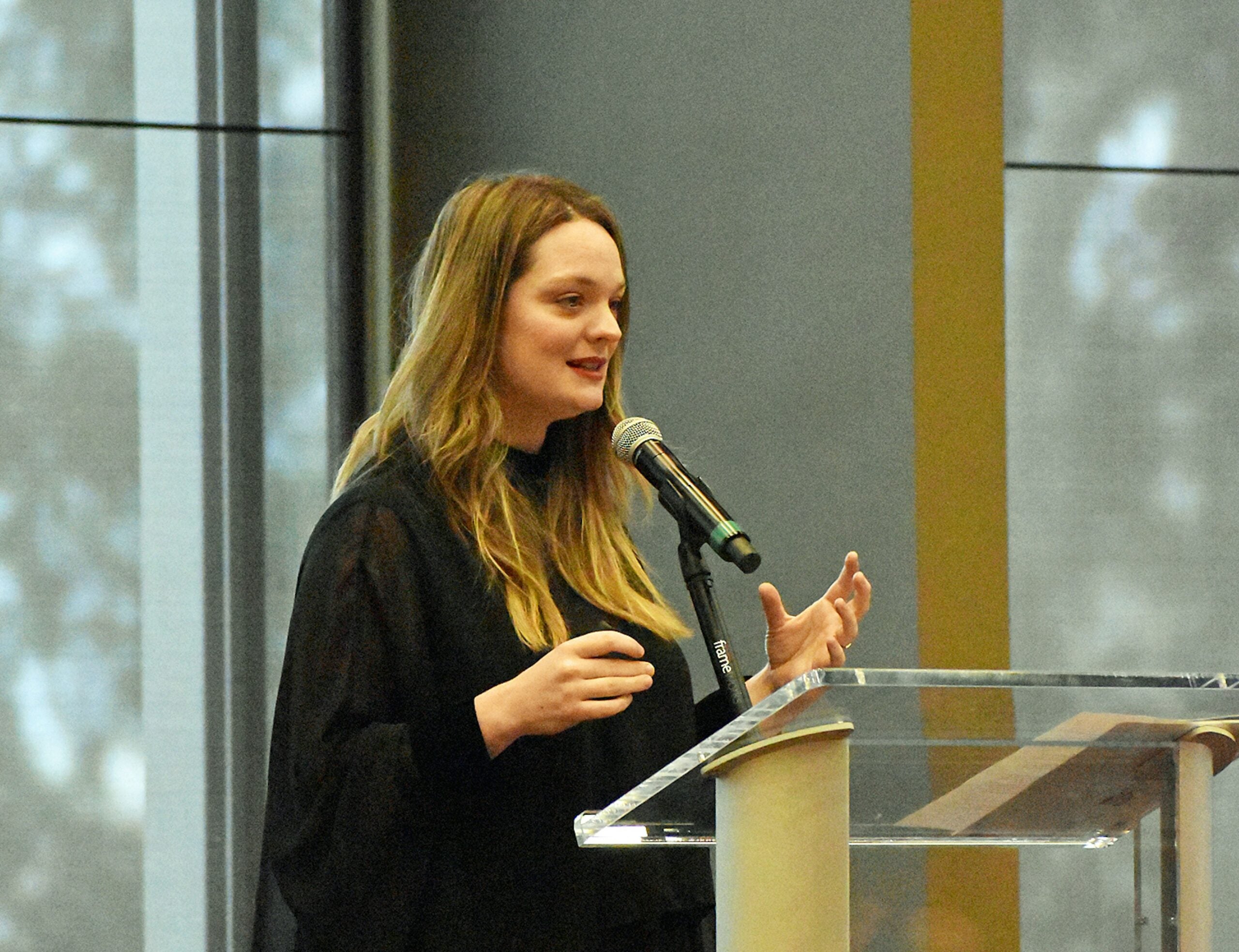SEIS and UCLA partners across campus welcomed Kate Robinson, who shared her father’s vision of transforming education through creativity and joy.
On Saturday, March 3, on the UCLA campus, 150 educators, community arts providers, and advocates turned out to attend “Imagine If: Powering Learning through Creativity and the Arts,” a day-long opportunity to learn about arts education and to come together to make the promise of Proposition 28, California’s new K-12 arts Initiative, a reality that makes the arts available to all students in the state.
“UCLA is a public university. Our responsibility, our mission, is research, teaching, and service. And so, with the passage of Proposition 28, we begin rich conversations about what kind of service can we contribute to this initiative,” said Annamarie Francois, associate dean of public engagement at the UCLA School of Education and Information Studies, in her opening remarks. “In the next weeks and months, UCLA will rise to the occasion to join and support all of you, to make your work more joyful and more meaningful for K-12 students. We want to put arts education at the core of our classrooms in California.”
The host for the day was Rory Pullens, executive arts education consultant, former senior executive director of arts education, LAUSD; and former CEO and head of school of the Duke Ellington School of the Arts in Washington, D.C. Other featured speakers included Matt Goldman, co-founder and CEO, Blue Man Group and co-founder and vice-chair of the board, Blue School, and advisor to the Office of Sir Ken Robinson; and Laurie Kurnick, manager of education and Brandon Santiago, chief development officer of Get Lit, a nonprofit arts organization working to ignite student engagement, literacy, and young voices around the globe. Olivia Le, a student poet who participates in Get Lit, also presented an original biographical poem, inspired by Jacqueline Woodson’s Newbery Award-winning book, “Brown Girl Dreaming.”
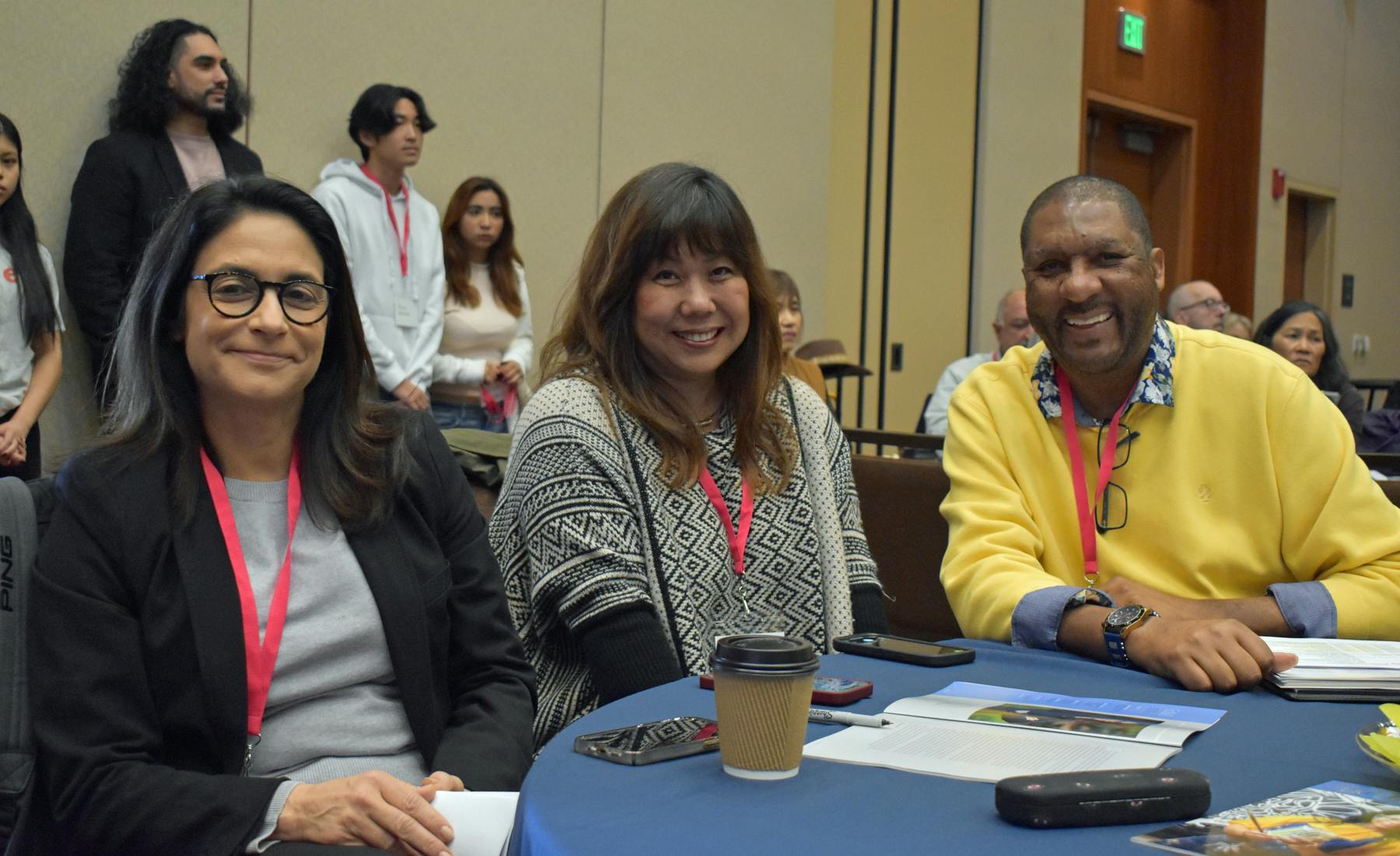
Wasserman Dean Christina Christie (at left) with Alison Yoshimoto-Towery (M.A. Education, UCLA, 2004), executive director of the UC-CSU California Collaborative for Neurodiversity and Learning; and Rory Pullens, executive arts education consultant. Photo by Michelle Trevino
Wasserman Dean Christina Christie extended her welcome on behalf of the UCLA School of Education and Information Studies, highlighting the main inspiration for the event, the work of the late Sir Ken Robinson, a global authority on creativity, education, and human potential. Celebrated for his transformative TED Talk, “Do Schools Kill Creativity”, Robinson believed deeply in the power of imagination. “Imagine If” celebrated Robinson’s philosophy that challenged world leaders, educators, and organizations to reimagine the world and its systems for the better and to champion the role of creativity in learning and life.
“A goal for today is to inspire you through the work and vision of Sir Ken Robinson,” said Dean Christie. “We are so deeply honored to have his daughter Kate with us today as our keynote speaker. Kate is working to extend her father’s vision of schools as centers for creativity and imagination and will share with you … her inspiring perspective on how we can best prepare students to develop solutions to address our most pressing issues, and how we can transform education so that we can better embrace all learners, including those who now sit both literally and intellectually outside of our classrooms.”
Christie underscored Sir Ken Robinson’s belief that the environment for creativity must be presented and nurtured for all learners.
“Sir Ken Robinson said that human resources are like natural resources, they are often very deep, you have to go looking for them,” she said. “You must create the circumstances where they show themselves. The goal in working with all of you as partners today is to infuse joy into the classroom by bringing creativity into the center of what we do, using our classrooms as the incubators for students’ curiosity, creativity, and imagination.
“Creativity in education promotes the development of critical thinking skills, problem-solving skills, and innovative approaches to learning and living,” said Christie. “Creativity in education helps students better engage in the learning process, leading to improved academic performance and increased motivation. Creativity in education can help students develop the skills they need to succeed in a rapidly changing world. And we now have the opportunity with the historic investment of Prop. 28 to show the world how to best center creativity and the arts in our classrooms.”
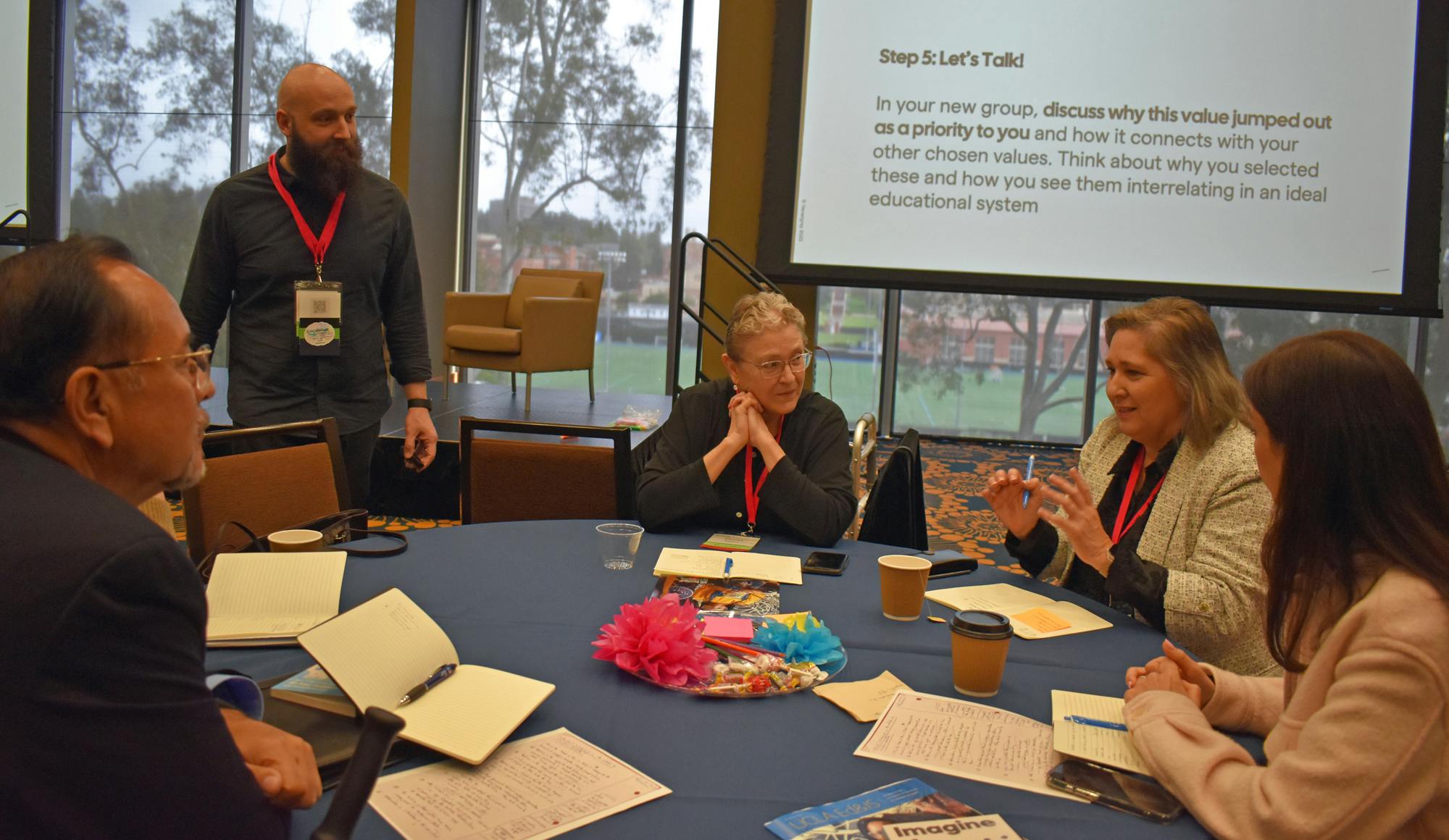
Anthony Dunn of the Office of Sir Ken Robinson (standing) co-led a session for teachers on the use of the Sir Ken Robinson Archive to further arts education. Photo by Michelle Trevino
Sir Ken Robinson passed away in 2020, but his message lives on through the words and work of his daughter Kate Robinson, who as keynote speaker offered insight into the scholar’s philosophy and inspiration. Drawing from “Imagine If – Creating a Future for Us All,” which she co-wrote with her father to preserve his message and philosophy for the future, Robinson spoke of his lifelong mission to transform education through the understanding of human beings’ unique experiences and gifts. Underscoring the need for joy in education, she exhorted the assembled educators to realize students’ actual gifts and potential in order to provide them with life-enhancing skills and experiences in the classroom.
“The average child spends 22,000 hours in formal education from kindergarten… not including college,” said Robinson, “… this unique soul … but also their own unique circumstances that they can’t leave at the door, no matter how much you ask them. You as educators know that you can’t make a child learn. You can pin them to a chair and make them rote memorize until they’re blue in the face, and they will forget it within ten years. The best you can do is create the conditions, and you do that by embracing the diversity of talents … that you have in your classroom.”
Robinson shared the last video that Sir Ken Robinson created, which was released during the COVID-19 pandemic, “A Future For Us All.” In it, he presented the ways that creativity can help address global crises of the environment, technology, and poverty, and decline in mental health.
“We have to do something different,” said Kate Robinson. “We’ve come to a crossroads in our evolution as a species, that we cannot continue to do what it is that we have always been doing. It’s just mind-blowing when you stop to think about the diversity of skills that we need as a species to function, not even to thrive.
“Creativity can be used in every sphere, which is why Prop. 28 has such amazing potential,” she said. “I think education has a purpose here, which is to enable students to understand the world around them … so that they can become fulfilled individuals and active and compassionate citizens. We need to transform and revolutionize education. You’re doing it already … what you’re doing every single day in classrooms is what matters. It matters to children, it matters to their parents, it matters to us as a society, and our futures depend on it.”
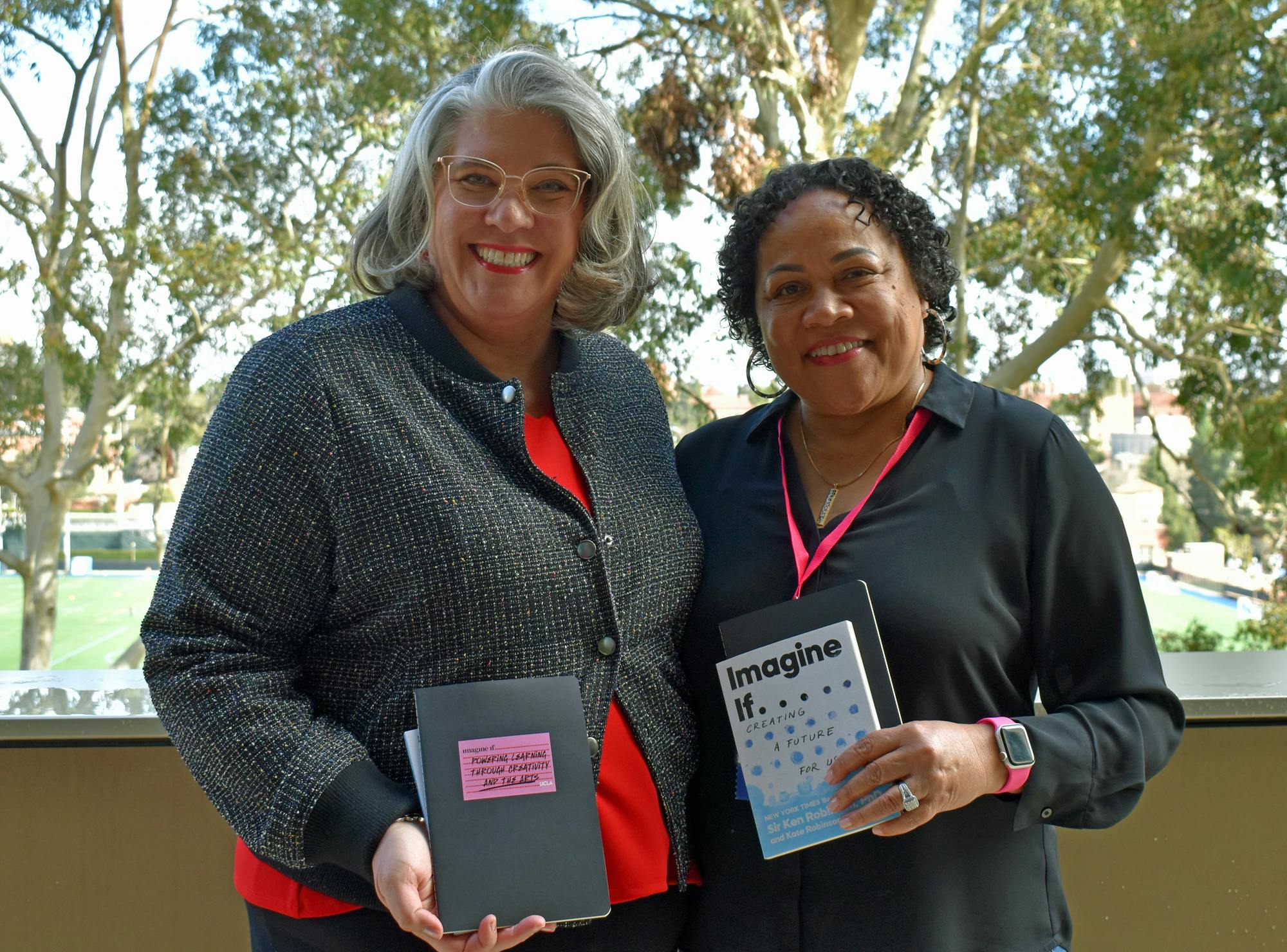
Jeannine Flores, member of the board of directors, CreateCA and arts consultant, LA County Office of Education; and Annamarie Francois, SEIS associate dean of public engagement. Photo by Michelle Trevino
Those attending “Imagine If” fanned out to participate in some 20 learning sessions, spread across a series of three workshops designed to promote learning and build community in support of arts education. Led by UCLA Ed&IS partners such as the Hammer Museum, UCLA’s Visual and Performing Arts Education (VAPAE) program, and the Herb Alpert School of Music, as well as arts educators from LAUSD and community partners such as The California Arts Project, Turnaround Arts, and the Lucas Museum of Narrative Art, the sessions ranged from professional development for arts and music in the classroom, to how museums, cultural institutions, and school communities can collaborate.
One key session was a discussion of the use of the Sir Ken Robinson Archive to further creativity in arts and education. In “Looking Back to Look Forward: Using the Sir Ken Robinson Archive to Power a Creative Revolution,” Kate Robinson and Anthony Dunn from The Office of Sir Ken Robinson, led participants in an exploration of the Sir Ken Robinson Archive, unveiling a never-before-seen treasure: a handwritten note penned by Sir Ken himself, detailing the reasons behind his passion for transforming education and serving as a compass, guiding educators toward innovative techniques to nurture creativity both within themselves and their classrooms. The session also engaged participants in a discussion of a broader vision for the Sir Ken Robinson Archive, and how it will serve as a “living workshop,” fueling a creative revolution in education and beyond.
Beret Malmgren, a theatre arts teacher who took part in the session, valued the experience.
“It’s very provocative to be asked or even to think about, ‘Imagine if,’ and so hopefully, other than just being energized, people walk away with a plan,” she said. “We were [asked] to think of what we value in education and to create our own personal manifesto. That’s something I think I will definitely work on.”
Lindsey Kunisaki a research and evaluation specialist for VAPAE and an Arts for LA Laura Zucker Fellow for Policy and Research, shared her work and perspective on “Culturally Sustaining Teaching and Learning for Secondary Performing Arts Classrooms.” Kunisaki contended that culturally sustaining teaching prompts an imaginative exploration of complex cultural identities and intersectionality, justice, and joy. In the workshop, educators explored a conceptual introduction to culturally sustaining pedagogy, followed by an interactive application of performing arts methods and activities including theatre arts, dance, poetry, music and more.
“My hope was to show how culturally sustaining teaching has a lot of unique features that I think are especially important in this moment, where access to arts education is expanding in really exciting ways,” Kunisaki said. “Culturally sustaining pedagogy gives us a way to ask some important questions about what that will look like, and for whom it will be. At its core, culturally sustaining pedagogy is about centering justice. I hope this session gave our participants some ideas about what that can look like, in really tangible ways.”
Other presenters explored specific strategies and practices for using the arts in the classroom. In “Designing Creative and Culturally Responsive Music Activities in Elementary Classrooms,” Lily Chen-Hafteck, professor of music education at the UCLA Herb Alpert School of Music, talked about music is a medium for emotional expression, is closely related to culture, and can strengthen one’s sense of identity. Creative music activities that allow students to express their emotions and cultural identities can help in achieving the goals of social-emotional learning. In the session, Chen-Hafteck discussed the dimensions of World Music Pedagogy and shared videos of students dancing and singing as they participated in musical activities of diverse cultures, demonstrating a creative and culturally responsive music curriculum.
“This was a really fun session and I feel like it definitely elevates my work,” said Celia Douglas, a teaching artist with Get Lit. “With poetry and spoken word, I believe there’s a musical element. Learning how I could structure one of my lesson plans and incorporate music and how I can use that with elementary school students, or even middle and high school students to create that performance work is extremely important.”
With their exploration of “Welcoming the Literary Aesthete in the Classroom,” Shervaughnna Anderson-Byrd and Tonikiaa Orange from the CA Reading & Literature Project and Center X Culture & Equity Project at the UCLA School of Education and Information, highlighted the connection and synergy between art and literacy, and how together, arts education provides culturally responsive ways for educators to support student observation, writing, speaking, and listening skills. Their presentation also highlighted how arts and literacy can inspire students to make meaning and new connections and take action.
Armalyn De La O, who represented The California Arts Project (TCAP), spoke to attendees on “Creating “Images of That Which Is Not Yet”: Strategies to Achieve Arts Education Equity,” a key session on how Prop. 28 will take shape in the state’s K-12 schools. She discussed the role of TCAP in establishing arts education equity that is grounded in the need to provide all students with the sequential learning of skills across the K-12 years, and if desired, the ability to pursue career opportunities within California’s creative economy. De La O also emphasized the challenge of gaining support for teachers from school leaders who did not experience arts education in their own schooling.
“Now they have the opportunity to make those decisions,” said De La O. “Our role as the California Arts Project, and probably, your role… as advocates for arts education, is to help them understand what that should look like: how does it happen strategically, with intention.”
Giselle Barrios, program coordinator for Inner City Arts, is one of the current generation of education professionals whose own schooling lacked arts education. She attended “Imagine If” to learn about how the East L.A.- based nonprofit can continue to serve LAUSD schools in the wake of Prop. 28. An alumna of the program herself, which has served Los Angeles schools since 1989, Barrios said that being able to take part in an arts program at all is what propelled her to higher education and a career.
“I was a student there in high school,” she said. “It drastically changed the course of my life, personally and professionally. I went to a very small charter school in downtown L.A., and … visual arts were only offered to one grade level. I had always wanted to dance. I was in paid private classes when I was younger, but my parents weren’t able to continue that financially. [Inner City Arts] was the reason I was able to go to college because they gave me so many opportunities. I was part of their paid internship program where they helped you with college and career readiness. Through them, I was able to realize that I didn’t necessarily want to be a dancer, but that I wanted to help students to also find their path in life.”
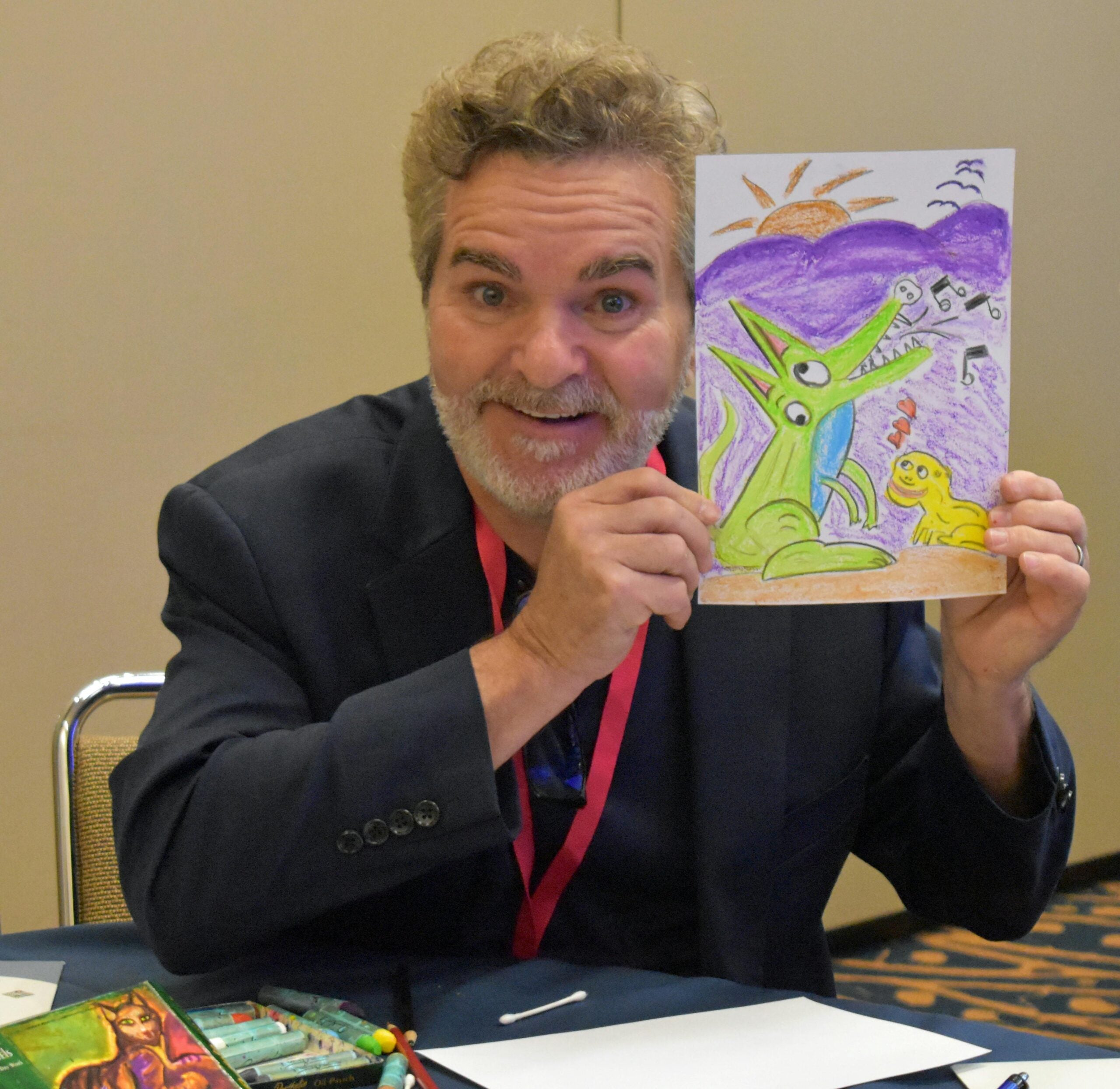
Teachers participated in roundtable discussions and enjoyed hands-on arts demonstrations to bring back to their classrooms. Photo by Michelle Trevino
As the day concluded, participants gathered in moving roundtable discussions about the vision and implementation of Proposition 28, facilitated by the most informed voices in Prop. 28’s background, implementation, and future. Conversations ranged from how to build effective arts partnerships, to the nuts and bolts of the initiative. At one table was a discussion of how those with arts backgrounds and skills could obtain Career Technical Education teaching credentials to work in classrooms. Another discussion focused on the need for colleges and universities to “speed things up” in preparing a new workforce of arts education teachers.
“I think that it’s very important to be able to communicate and socialize with your peers,” Malmgren said. “Teaching is a very isolated profession so to be able to sit down at a table and dialogue with people, is great, especially outside of school. People are excited to be here, and they’re bringing good energy. That’s where you get to problem-solving or solutions.”
“Today has been very insightful in seeing a bigger picture of how we can get there and come together as a community… as teachers and educators to make that happen,” said Douglas.
